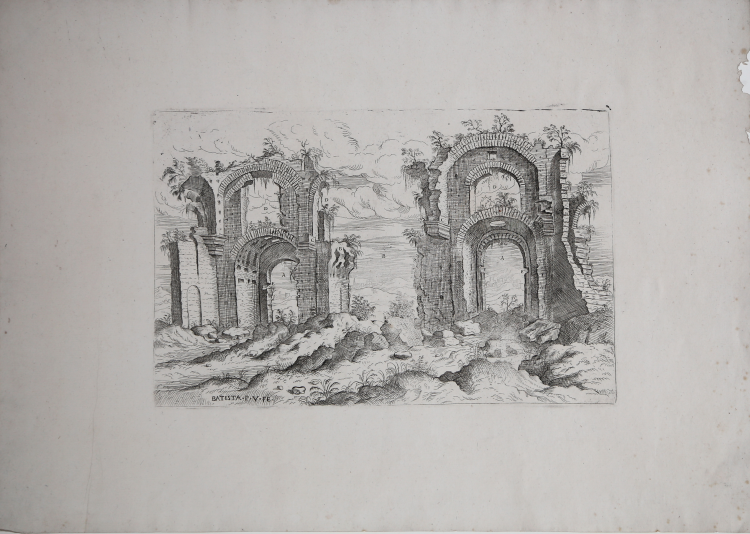



| Reference: | S37023 |
| Author | Giovanni Battista PITTONI detto "Battista Vicentino" |
| Year: | 1561 ca. |
| Zone: | Terme di Diocleziano |
| Printed: | Rome |
| Measures: | 325 x 210 mm |


| Reference: | S37023 |
| Author | Giovanni Battista PITTONI detto "Battista Vicentino" |
| Year: | 1561 ca. |
| Zone: | Terme di Diocleziano |
| Printed: | Rome |
| Measures: | 325 x 210 mm |
Etching and engraving, 1561. Example of the third issue, printed without text on verso in the middle of the 17th Century.
First published in the rare Praecipua aliquot romanae antiquitatis ruinarum monumenta par baptistam Pittonem vicentinum mense september MDLXI, inspired by the same work by Hieronimus Cock, printed in Antwerp in 1551 (frontispiece and 24 plates).
“All ruins bespeak both persistence and decay. Yet the specificity of Roman ruins, for the Antwerp publisher Hieronymus Cock (c. 1510—1570), lay less in a charged sublimnity than in a lingering power to model, to furnish templates in his Netherlandish here-and-now. Cock's astonishing series of etchings, the Praecipua Aliquot Romanae Monimenta was published in 1551. One of the earliest products of Cock's revolutionary Aux Quatre Vents firm, the Praecipua has long proven problematic to art historians, since it seems less to document ancient Rome than to present the city as landscape, a sprawl of disabled structures. Writing in 1907, for example, the archaeologist Hülsen complained that Cock's views 'teach us nearly nothing' of antiquity, and 'depict only how grave the monuments' "en-rubblement" (Verschüttung) has become'. Yet the sixteenth-century appeal of Cock's prints lay precisely with this enactment of decay. For his audiences Cock fragmented views of the Colosseum, blurred distances between buildings like the Septizodium and the Baths of Diocletian and dotted the ruins with tiny animals and human figures. Ultimately, the etchings mattered not as antiquarian documents but as pattern prints, templates re-used and excerpted by German intarsists, Dutch metalsmiths, and Italian painters. It was the print medium that enabled such copia to reconstruct a Rome that was no longer there, less by showing it than re-staging via a kind of antiquarian virtuality, its aesthetic of bricolage” (cf. Christopher P. Heuer, Hieronymus Cock's Aesthetic of Collapse, pp. 387, 389-408, Oxford 2009).
The plates by Pittoni were later reprinted in 1582 and included in the Vincenzo Scamozzi Discorsi sopra l'Antichità di Roma, where the views are weaker and with a descriptive text, on verso.
Giovanni Battista PITTONI detto "Battista Vicentino" (Vicenza 1520 - 1583)
|
Italian printmaker. He settled in Venice in 1558 and from 1561 made etchings of maps, as well as of series of ornaments (inspired by the plates of Antonio Fantuzzi) and, above all, landscapes of the surroundings of Rome and Naples. In particular he copied the romantic views by Hieronymus Cock in Praecipua aliquot romanae antiquitatis ruinarum monumenta (Venice, 1561) to illustrate the treatise by Vincenzo Scamozzi Discorsi sopra le antichità di Roma (Venice, 1582). In 1562 Pittoni began to publish two volumes of a collection entitled Imprese di diversi principi, duchi, signori, which was an immediate success and went through several editions in the late 16th century. For a long time he was confused with Battista dell’ Angolo del Moro, with whom he worked in very close collaboration, and with Andrea Schiavone. His prints are usually signed B.P.V. (Battista Pittoni Vicentino).
|
Giovanni Battista PITTONI detto "Battista Vicentino" (Vicenza 1520 - 1583)
|
Italian printmaker. He settled in Venice in 1558 and from 1561 made etchings of maps, as well as of series of ornaments (inspired by the plates of Antonio Fantuzzi) and, above all, landscapes of the surroundings of Rome and Naples. In particular he copied the romantic views by Hieronymus Cock in Praecipua aliquot romanae antiquitatis ruinarum monumenta (Venice, 1561) to illustrate the treatise by Vincenzo Scamozzi Discorsi sopra le antichità di Roma (Venice, 1582). In 1562 Pittoni began to publish two volumes of a collection entitled Imprese di diversi principi, duchi, signori, which was an immediate success and went through several editions in the late 16th century. For a long time he was confused with Battista dell’ Angolo del Moro, with whom he worked in very close collaboration, and with Andrea Schiavone. His prints are usually signed B.P.V. (Battista Pittoni Vicentino).
|